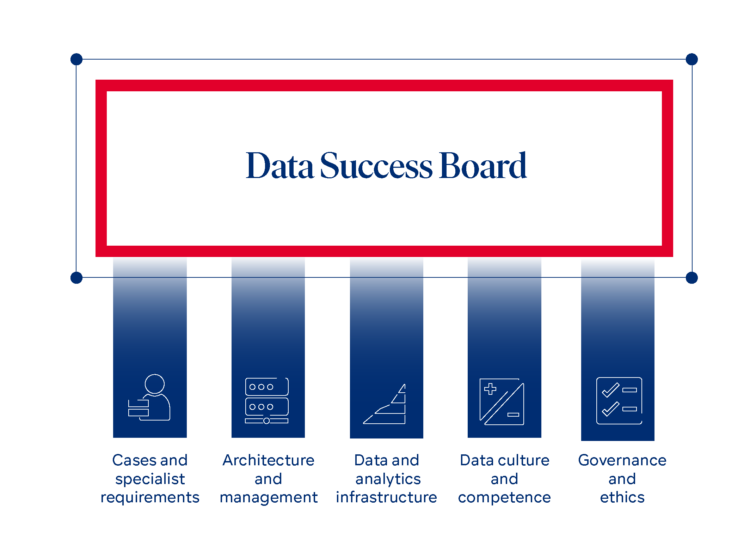
From CDO to Data Success Board: how to successfully transform into a data-driven company
Gaining data-based insights and making decisions, optimizing processes with data, using (generative) AI: there are plenty of companies that want all of this. You occupy the role of chief data officer (CDO), the person who is supposed to set up and implement a suitable data strategy - and in many cases this fails. But why? Because this subject is almost impossible to tackle alone. In this article, we will show you why data is better approached as a team sport and how the "Data Success Board" helps to anchor and implement the data strategy in the company over the long term.
the company over the long term.
Without data, we have to resort to guesswork… The fact that data is of key importance in our increasingly digital world has been well known for a while now. Companies need this data to analyze customer needs and derive sales measures in order to optimize products and services and make processes more efficient. However, for a long time, the data was housed in the controlling department. Nonetheless, this didn’t stop the data from showing up in various other departments and staff units. Most companies have now attained a level of digital maturity that comes with an understanding of the importance of end-to-end digital and data-driven processes. Data should be accessible and usable in all processes, across departments, and systems. Not least, this ensures that new technologies, such as generative AI, can be effectively utilized.
The crux of the matter is that, in many cases, the concrete vision of a data-driven company remains unclear. Historically developed application landscapes, data silos, and disruptions in media and processes often make it difficult to achieve this target vision. The data landscape and data streams must first be documented, consolidated, and streamlined. Only then can specific use cases for improving data utilization be identified and implemented. This, in turn, requires expertise in new technologies such as machine learning and generative AI, as well as “data literacy” as a general competency.
“It takes a village to raise a child”
The saying implies that successful, holistic education requires the combined experience of many individuals. This also applies to the data strategy. After all, how can one person alone be expected to have an overview of all departments, processes, tasks, associated systems, and data, and find optimal solutions for all use cases? It requires the perspectives of specialist departments, the tech expertise, and the insights of management. Data cannot simply be added as a new organizational area alongside business and IT; it is a cross-cutting issue that impacts all areas of the company, involving everyone.
From CDO to Data Success Board
What can it look like in concrete terms if “everyone” is involved? In our experience, one effective control model that has demonstrated success in practice is the Data Success Board. It ensures that the topic of data is anchored at the C-level and integrated into the strategy process. Initially, members include representatives from management who provide business and IT perspectives, often including the chief data officer (CDO), who offers a centralized view of data to the committee. Because of its composition, the Board maintains close links with relevant stakeholders in the organization, such as:
- Works council or staff council
- Compliance officer
- Data protection officer
- Representatives of the departments
They all contribute their experience in managing data. They understand where processes falter and tasks become more challenging due to missing, duplicate, or outdated data, and where simplification of data maintenance is needed. Together, they can discuss the need for new solutions and process improvements, and create synergies in the process. And the role of the chief data officer? It remains. Rather than addressing the data strategy issue alone, it is now distributed across multiple shoulders. The CDO facilitates the board discussions and assumes the lead role in implementing the strategy.
Moving forward with implementation with the Data Success Board
As a committee, the Data Success Board coordinates the strategic management of data and develops the vision for transforming into a data-driven company. For this vision to be effectively operationalized, a sustainable structure is essential for its implementation. The Data Success Board rests on five operational pillars that have proven effective. Each pillar represents a distinct strand of work within the overall project, each with its own designated leader. High-level horizontal networking between divisions is a critical success factor in implementation.

Anchoring & operationalizing data strategy sustainably
The introduction of a Data Success Board and the implementation of the five pillars offer companies a structured approach for successfully implementing the transformation to a data-driven company. However, the journey to becoming a data-driven company is not a one-time effort; it is an ongoing process that demands continuous development and adaptation. The set of methods presented here provides exactly the right basis for this.
If you would like to discuss the Data Success Board and the topic of data strategy in more detail, please contact Dr. Markus Knappitsch and his colleagues: You can contact them here.
